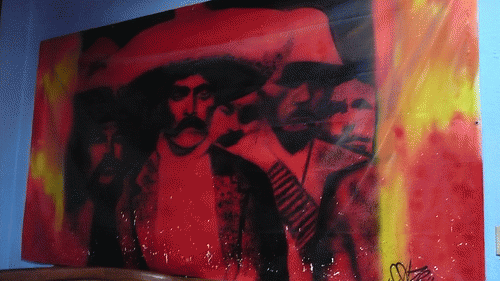Villa and Zapata: A History of the Mexican Revolution, By Frank McLynn (2001)
-
-
Emiliano by Marco Cedena, Flickr
-
Emiliano Zapata and Pancho Villa were the most prominent and remembered among the constellations of men at war and movements in Mexico from 1910 to 1920, but the book's attention to so many facets of that decade of Mexican history - and how these melded into Woodrow Wilson's America and the First World War in Europe - was its most remarkable feature to me.
Permit me as a compliment to “Villa and Zapata” to paraphrase at some length from two of its parts describing the deaths of those two prominent and remembered but very different warriors, and then briefly from the book's Conclusion.
First died Emiliano Zapata -
'On April 10, 1919, Zapata and his escorts rode down the hills towards a hacienda - in familiar territory, as he had taken it in early 1911. There were shops outside the hacienda, and Zapata stopped and conferred there with his escorts. Jesus Guajardo, who was to accept Zapata's surrender at the hacienda, came outside and joined Zapata and his escorts. Only one Zapatista had entered the hacienda - Zapata's principal aid Miguel Palacios was discussing the handover of 12,000 rounds of ammunition. Outside Guajardo suggested to Zapata that they ride inside the hacienda walls for dinner. Zapata was wary but tired and hungry, and so he acceded, taking a bodyguard of just ten men. He mounted his horse and rode into the hacienda's plaza, as Guajardo's guard of honor stood at attention - paying their visitor a great compliment. A bugle sounded and the guard presented arms. The last note sounded and Zapata had reached the threshold of the building when the guards opened fire at point-blank range. Zapata died immediately, and Palacios and two of the escort also perished. The rest of the Zapatistas fled for their lives.'
Pancho Villa lasted four long years more -
'On July 20, 1923, Villa drove to Canutillo in a large Dodge saloon with six men. In the town, at the intersection of Benito Juarez and Claro Hurtado streets, there was an old man selling candy and he cried out Viva Villa! It was a prearranged signal, and as Villa turned the corner he ran into a fusillade of bullets. He was killed instantly. The Dodge went out of control and hit a tree. One of Villa's companions managed to crawl under the car and play dead while a gunman ran up and pumped more bullets into Villa's head. Another companion managed to kill one of the assailants before making good his escape. Claro Hurtado was less fortunate. Trying to get away down a river bank, his way was blocked and he was gunned down when he turned back.'
And from the book's Conclusion -
'The Mexican Revolution was a ten-year Iliad, in which Villa, Zapata, Obregon and Carranza played the roles in fact which were played in myth by Agamemnon, Achilles, Hector, and Aeneas. Historians estimate that the death toll was between 350,000 and 1,000,000, excluding the victims of the 1918 flu epidemic, which added another 300,000 to the list of fatalities. Civilization's thin veneer was never thinner than in the Mexican Revolution, and the moral is surely that even in advanced societies we skate all the time on the thinnest of ice. And a seemingly trivial political crisis can open up the ravening maw of an underworld of chaos.'






